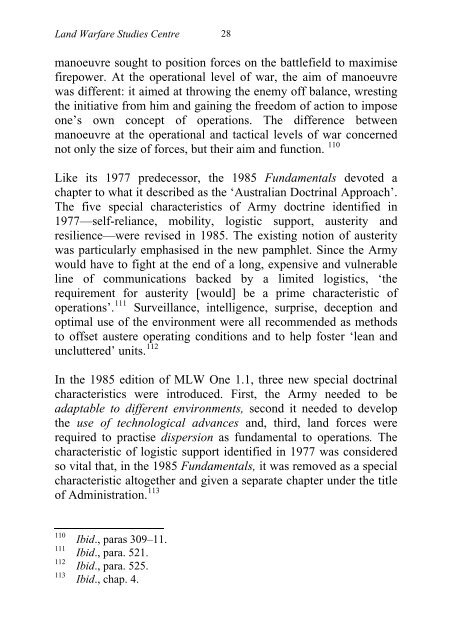Ibid - Australian Army
Ibid - Australian Army
Ibid - Australian Army
Create successful ePaper yourself
Turn your PDF publications into a flip-book with our unique Google optimized e-Paper software.
Land Warfare Studies Centre 28<br />
manoeuvre sought to position forces on the battlefield to maximise<br />
firepower. At the operational level of war, the aim of manoeuvre<br />
was different: it aimed at throwing the enemy off balance, wresting<br />
the initiative from him and gaining the freedom of action to impose<br />
one’s own concept of operations. The difference between<br />
manoeuvre at the operational and tactical levels of war concerned<br />
not only the size of forces, but their aim and function. 110<br />
Like its 1977 predecessor, the 1985 Fundamentals devoted a<br />
chapter to what it described as the ‘<strong>Australian</strong> Doctrinal Approach’.<br />
The five special characteristics of <strong>Army</strong> doctrine identified in<br />
1977—self-reliance, mobility, logistic support, austerity and<br />
resilience—were revised in 1985. The existing notion of austerity<br />
was particularly emphasised in the new pamphlet. Since the <strong>Army</strong><br />
would have to fight at the end of a long, expensive and vulnerable<br />
line of communications backed by a limited logistics, ‘the<br />
requirement for austerity [would] be a prime characteristic of<br />
operations’. 111 Surveillance, intelligence, surprise, deception and<br />
optimal use of the environment were all recommended as methods<br />
to offset austere operating conditions and to help foster ‘lean and<br />
uncluttered’ units. 112<br />
In the 1985 edition of MLW One 1.1, three new special doctrinal<br />
characteristics were introduced. First, the <strong>Army</strong> needed to be<br />
adaptable to different environments, second it needed to develop<br />
the use of technological advances and, third, land forces were<br />
required to practise dispersion as fundamental to operations. The<br />
characteristic of logistic support identified in 1977 was considered<br />
so vital that, in the 1985 Fundamentals, it was removed as a special<br />
characteristic altogether and given a separate chapter under the title<br />
of Administration. 113<br />
110<br />
111<br />
112<br />
113<br />
<strong>Ibid</strong>., paras 309–11.<br />
<strong>Ibid</strong>., para. 521.<br />
<strong>Ibid</strong>., para. 525.<br />
<strong>Ibid</strong>., chap. 4.

















